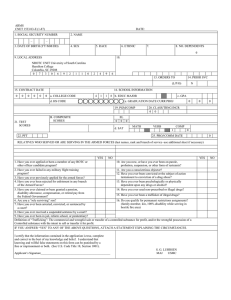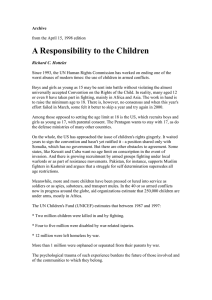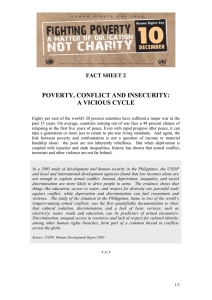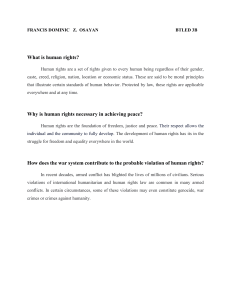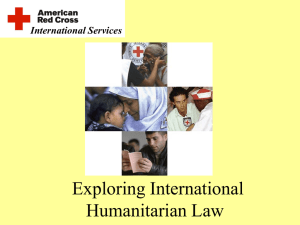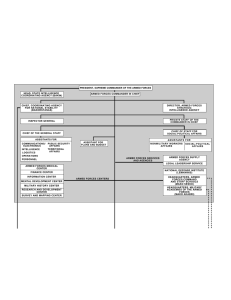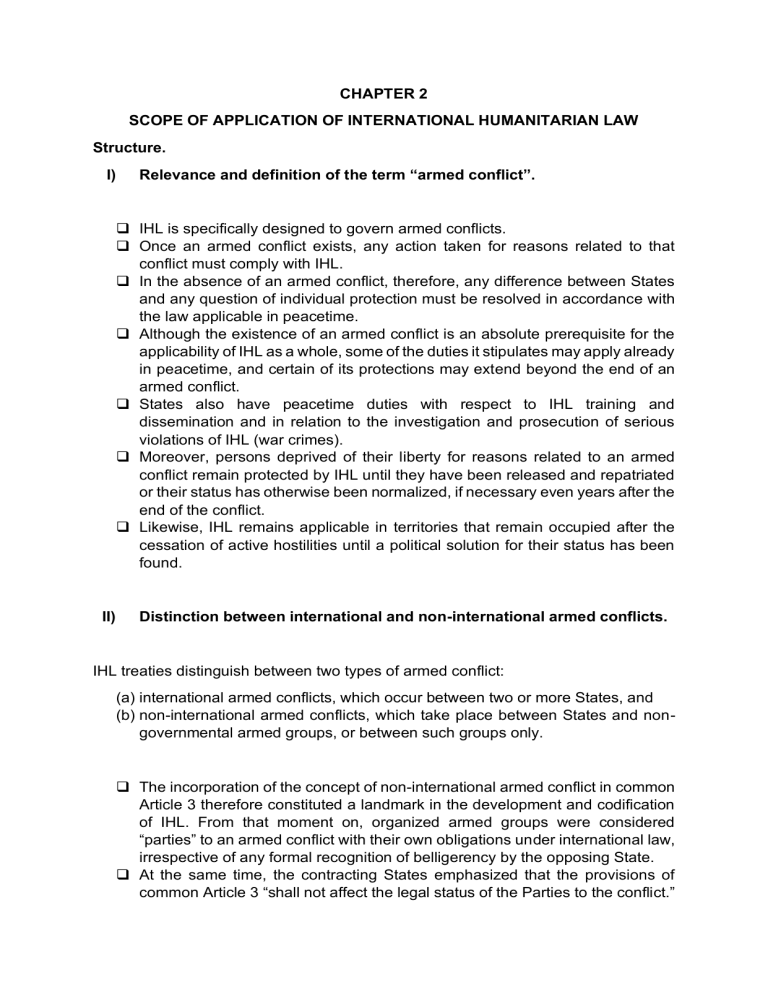
CHAPTER 2 SCOPE OF APPLICATION OF INTERNATIONAL HUMANITARIAN LAW Structure. I) Relevance and definition of the term “armed conflict”. ❑ IHL is specifically designed to govern armed conflicts. ❑ Once an armed conflict exists, any action taken for reasons related to that conflict must comply with IHL. ❑ In the absence of an armed conflict, therefore, any difference between States and any question of individual protection must be resolved in accordance with the law applicable in peacetime. ❑ Although the existence of an armed conflict is an absolute prerequisite for the applicability of IHL as a whole, some of the duties it stipulates may apply already in peacetime, and certain of its protections may extend beyond the end of an armed conflict. ❑ States also have peacetime duties with respect to IHL training and dissemination and in relation to the investigation and prosecution of serious violations of IHL (war crimes). ❑ Moreover, persons deprived of their liberty for reasons related to an armed conflict remain protected by IHL until they have been released and repatriated or their status has otherwise been normalized, if necessary even years after the end of the conflict. ❑ Likewise, IHL remains applicable in territories that remain occupied after the cessation of active hostilities until a political solution for their status has been found. II) Distinction between international and non-international armed conflicts. IHL treaties distinguish between two types of armed conflict: (a) international armed conflicts, which occur between two or more States, and (b) non-international armed conflicts, which take place between States and nongovernmental armed groups, or between such groups only. ❑ The incorporation of the concept of non-international armed conflict in common Article 3 therefore constituted a landmark in the development and codification of IHL. From that moment on, organized armed groups were considered “parties” to an armed conflict with their own obligations under international law, irrespective of any formal recognition of belligerency by the opposing State. ❑ At the same time, the contracting States emphasized that the provisions of common Article 3 “shall not affect the legal status of the Parties to the conflict.” ❑ The most important difference concerns the threshold of violence required for a situation to be deemed an armed conflict. ❑ As a consequence, the threshold of violence required to trigger a noninternational armed conflict and, thereby, the applicability of IHL is significantly higher than for an international armed conflict. ❑ Jus ad bellum imposes a general prohibition on the use of force between States. III) International armed conflicts. 1. Treaty Law. ❑ The classic form of armed conflict is international in character and waged between two or more States. ❑ IHL governing situations of international armed conflict is codified primarily in the Hague Regulations of 1907, the four 1949 Geneva Conventions and Additional Protocol I. ❑ Common Article 2 provides that: “[i]n addition to the provisions which shall be implemented in peacetime, the present Convention shall apply to all cases of declared war or of any other armed conflict which may arise between two or more of the High Contracting Parties, even if the state of war is not recognized by one of them; and to all cases of partial or total occupation of the territory of a High Contracting Party, even if the said occupation meets with no armed resistance.” ❑ For States that have ratified Additional Protocol I, the situations referred to in common Article 2 also include: “armed conflicts in which peoples are fighting against colonial domination and alien occupation and against racist régimes in the exercise of their right of self-determination. ❑ The existence of an international armed conflict essentially depends on two elements, namely the legal status of the belligerent parties and the nature of the confrontation between them. 2. Legal status of the belligerent parties. ❑ States party to Additional Protocol I have further agreed to recognize certain types of national liberation movements as “parties” to an international armed conflict although they do not, at the time, qualify as sovereign States under international law. 3. Nature of the confrontation: “war,” “armed conflict” and “occupation. ❑ International armed conflicts are belligerent confrontations between two or more States. ❑ Today, an international armed conflict is presumed to exist as soon as a State uses armed force against another State, regardless of the reasons for or intensity of the confrontation, and irrespective of whether a political state of war has been formally declared or recognized. ❑ In the special case of national liberation movements, the required threshold of violence may be more similar to that of situations of non-international armed conflict, depending on whether the factual circumstances more closely resemble the relationship between sovereign States or that between a governmental authority and a non-State armed group. ❑ First, the applicability of IHL can still be triggered by a formal declaration of war. ❑ IHL automatically applies where the territory of one State is totally or partially occupied by another State without the latter’s genuine consent, even when such occupation meets with no armed resistance. 4. Temporal and territorial scope of international armed conflicts. (a) Temporal scope of international armed conflict. ❑ The applicability of IHL governing international armed conflicts begins with a declaration of war or, in the absence of such declaration, with the actual use of armed force expressing belligerent intent. ❑ It is also triggered by the mere fact of one State invading another with a view to occupying all or part of its territory, even when such an invasion meets with no armed resistance. (b) Territorial scope of international armed conflicts. ❑ In terms of territorial scope, the interpretation of the ICTY does not imply that IHL cannot apply outside the territory of the belligerent parties. ❑ It is merely intended to clarify that the applicability of IHL cannot be limited to those areas of belligerent States where actual combat takes place, but that it extends to any act having a nexus to the conflict (i.e. carried out for reasons related to the conflict). IV) Belligerent occupation. 1. Treaty Law. ❑ In essence, belligerent occupation occurs when one State invades another State and establishes military control over part or all of its territory. ❑ Accordingly, Article 42 of the Hague Regulations states: “Territory is considered occupied when it is actually placed under the authority of the hostile army. ❑ The occupation extends only to the territory where such authority has been established and can be exercised.” 2. Prerequisite of “effective control”. ❑ Whether a territory is occupied within the meaning of IHL is a question of fact and, in essence, depends on whether the occupying power has established effective control over the territory in question. ❑ The existence of occupation depends on a State’s factual ability to assume the de facto governmental functions of an occupying power, most notably to ensure public security, and law and order, and not by its willingness to do so. 3. Invasion phase. ❑ While the text of Article 42 of the Hague Regulations is clear that territory cannot be considered occupied during the invasion preceding the establishment of effective control, the extent to which the Fourth Geneva Convention applies during that phase is less clear. 4. End of occupation. ❑ Although some territories, such as the occupied Palestinian territory, have been occupied for decades, the occupying power’s role as a de facto authority remains by definition temporary. ❑ Determining the end of belligerent occupation, however, has rightly been described as a “thorny task” fraught with political and legal issues of significant complexity. a. Withdrawal or loss of effective control. b. Genuine consent to a foreign military presence. c. Political settlement of the territorial status 5. Multinational administration of territories. ❑ Recent years have seen novel forms of multinational territorial administration. ❑ This raises the question of the extent to which such deployments could give rise to situations of belligerent occupation under IHL, or whether the legal and policy framework governing such deployments should be shaped by elements of the law of occupation V) Non-international armed conflicts. ❑ The vast majority of contemporary armed conflicts are waged, not between States, but between States and organized armed groups or between such groups – they are non-international in character. ❑ Treaty IHL governing non-international armed conflicts consists, first and foremost, of common Article 3 and Additional Protocol II. ❑ Last but not least, owing to the relative scarcity of applicable treaty IHL, customary law is of great importance for the regulation of non-international armed conflicts. 1. Article 3 common to the 1949 Geneva Conventions. ❑ States would agree to fully apply all four Conventions to non-international armed conflicts only at the price of a very narrow definition of noninternational armed conflict that was highly unlikely to be met in reality. ❑ Accordingly, common Article 3 simply identifies a number of key duties and prohibitions providing a minimum of protection to all persons who are not, or who are no longer, taking an active part in the hostilities. ❑ In return, this “miniature Convention” must be applied “as a minimum” by each party to any “armed conflict not of an international character.” ❑ A non-international armed conflict within the meaning of common Article 3 does not necessarily have to involve a government; it can also take place entirely between organized armed groups, a scenario that is particularly relevant in areas of weak governance, such as so-called “failed States.” ❑ The concept of “party to an armed conflict” presupposes a minimum level of organization without which coordinated military operations and collective compliance with IHL would not be possible. ❑ Furthermore, in order to qualify as an “armed conflict,” non-international confrontations must always involve violence that reaches a certain threshold of intensity. 2. Article 1 of Additional Protocol II. ❑ Additional Protocol II, which was adopted in 1977, develops and supplements common Article 3. Article 1 of the Protocol reads: “1. This Protocol (...) shall apply to all armed conflicts which are not [of international character] and which take place in the territory of a High Contracting Party between its armed forces and dissident armed forces or other organized armed groups which, under responsible command, exercise such control over a part of its territory as to enable them to carry out sustained and concerted military operations and to implement this Protocol. 2. This Protocol shall not apply to situations of internal disturbances and tensions, such as riots, isolated and sporadic acts of violence and other acts of a similar nature, as not being armed conflicts.” Thus, in contrast to common Article 3, Additional Protocol II applies only to armed conflicts involving a contracting State as a party to the conflict and taking place in the territory of that State. Moreover, part of the State’s territory must be under the effective control of the opposition forces. 3. Threshold of organization. ❑ Without a minimum level of organization, it is impossible to conduct coordinated military operations and to ensure collective compliance with IHL. ❑ While State armed forces are generally presumed to satisfy this criterion, the level of organization of non-State armed groups has in practice been assessed based on a series of indicative factors including elements such as: “the existence of a command structure and disciplinary rules and mechanisms within the group; the existence of a headquarters; the fact that the group controls a certain territory; the ability of the group to gain access to weapons, other military equipment, recruits and military training; its ability to plan, coordinate and carry out military operations, including troop movements and logistics; its ability to define a unified military strategy and use military tactics; and its ability to speak 4. ❑ ❑ 5. with one voice and negotiate and conclude agreements such as cease-fire or peace accords.” Threshold of intensity. Accordingly, in order for a non-international armed conflict to exist, the ICTY requires a situation of “protracted armed violence” between a State and organized armed groups or between such groups,103 a criterion that in practice has been interpreted as referring more to the intensity of the armed violence than to its duration. Indicative factors for assessing “intensity” have included: “the number, duration and intensity of individual confrontations; the type of weapons and other military equipment used; the number and caliber of munitions fired; the number of persons and type of forces partaking in the fighting; the number of casualties; the extent of material destruction; and the number of civilians fleeing combat zones. Temporal and territorial scope of non-international armed conflicts. (a) Temporal scope of non-international armed conflicts. In terms of temporal scope, non-international armed conflicts begin as soon as armed violence occurring between sufficiently organized parties reaches the required threshold of intensity. (b) Territorial scope of non-international armed conflicts. In terms of territorial scope, the applicability of both common Article 3 and Additional Protocol II is restricted to armed conflicts taking place “in the territory” of a High Contracting Party; the Protocol even requires that the territorial State be involved as a party to the conflict. Today, the territorial restriction of the scope of applicability of common Article 3 and Additional Protocol II no longer serves its original purpose. VI) Armed conflicts involving foreign intervention. ❑ Armed conflicts subject to foreign intervention are a special form of armed conflict sometimes also less accurately referred to as “internationalized” armed conflicts. In essence, this concept refers to a State, or coalition of States, intervening in a pre-existing non-international armed conflict, thereby becoming a (co-belligerent) party to that conflict.

